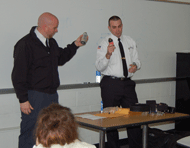College of Humanities & Social Sciences
College of Humanities & Social Sciences
Law & Justice Studies alumni, Officers Rafter and DeFoney, speak to first-semester students
If you were walking through Wilson Hall on Tuesday, December 4th, you might be curious about the activity in Dr. Christine Saum's Survey of Criminal Justice-Rowan Seminar course. What were two uniformed officers doing in the classroom, and why did they need riot gear? As it turns out, first-semester Law & Justice Studies students were treated to a visit from two Rowan alumni, Officers Matthew Rafter ('09) and Joseph DeFoney ('10).
Rafter and DeFoney are both employed as corrections officers at the Federal Correctional Institution (FCI) in Fairton, a medium security facility for male offenders located in rural south central New Jersey. Crimes committed by offenders at FCI Fairton range from tax evasion to weapons charges to violent offenses such as rape. According to Rafter, the prisoner to officer ratio is approximately 170:1, and officers are equipped with a chain and radio holder only. In order to maintain the safety of the officers and prisoners, specialized training is required. "Your best weapons are your mouth and words," suggests Rafter, who said that talking an inmate out of a committing a violent act is often the best option.
While they were students in the Law & Justices Studies program at Rowan, Rafter and DeFoney had different careers in mind. Rafter had participated in the Ocean City police academy while attending school, and his goal was to become a police officer. DeFoney originally planned to attend law school, but became interested in law enforcement after becoming a member of the Student Patrol. Since graduating, both have found an opportunity for employment with the Federal Bureau of Prisons and highlight the good salary and benefits that come with federal government positions.
During their visit, Rafter and DeFoney provided insight into the daily routine of the prisoners, which includes work and recreational activities. "The prisoners walk around more freely than you see on TV," explained Rafter and DeFoney. The system is designed to keep prisoners as busy as possible, since "idle time can lead to mischief," according to Rafter. Educational opportunities are provided, as a major goal of the prison system is to lower rates of recidivism-a relapse into criminal activity.
Students were able to see and handle specialized equipment employed by the Disturbance Control Teams (DCT) that are trained in the use of less-than-lethal weapons for major disturbances. Additionally, photos of contraband as well as an actual shank made with a plastic toothbrush were passed around.
One student asked about the role of women in the prisons, and Rafter explained that one of their best investigators is a woman who has expertise in gang activity. DeFoney advised that in order to do the job of a corrections officer, a little bit of fear is normal and healthy. The most poignant reminder of the important (and dangerous) role of law enforcement officials came from Rafter who explained that the "major goal in law enforcement is to make sure you and your fellow officers go home safe that night."
Not only do we appreciate the work of Officers Rafter and DeFoney, but also their generosity in giving back to the institution of their time and expertise.

Officers Joseph DeFoney (left) and Matthew Rafter (right)



